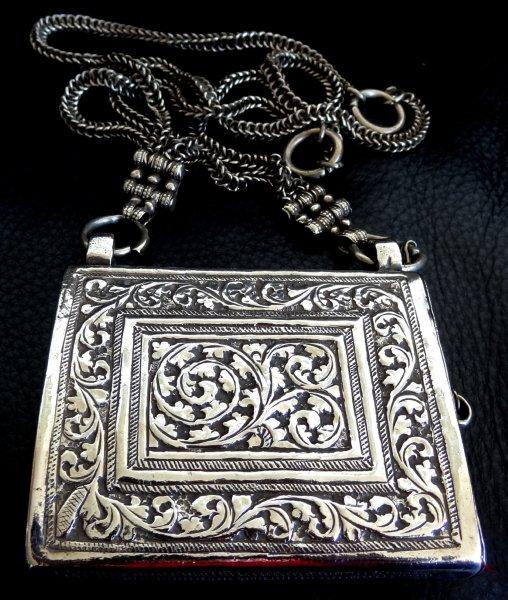 |
|
Omani Khanjar
|
The website contains hundreds of photos of antique objects, people and buildings from or relating to Oman / Zanzibar. The main objective of this website is to give some historic and social background to the objects. This will provide better insight in Omani history and culture including arts and crafts. The highlight of Omani arts and crafts is the old Omani silver dagger (khanjar), which is represented on the current Omani national flag. We also try to link objects to similar items in public collections and to to descriptions in early books about Oman and Zanzibar.

The current Omani Flag (including a Saidi khanjar and two swords)
The original Omani flag was just plain red!
Oman and Zanzibar were tolerant to other religions and traders and therefore through the centuries many different people came to Oman and established themselves in the country including Baluchi, Farsi, Ismaili, Lawatija´s, Yemeni from the Hadrhamout, Jews from Baghad, Hindi, Wahabi´s, people from the Comoros etc. Also many thousands of slaves were "imported" from East Africa and eventually mixed with the population. The skills and cultures of these peoples influenced and enriched the arts and crafts in the country. Already during the first half of the 19th century the United States were an important trading partner of Oman and a significant portion of the Omani date harvest was exported to the States!! The US harbour of Salem played an important role in the trade with Oman and Zanzibar. In 1840 an Omani ship the Al-Sultanah with captain Ahmad bin Na´aman went on an official visit to the USA.
The artefacts shown on this website generally date from before 1950 and a very large part date from before 1900. By documenting the collection we want to give an overview of the variety of antique Omani arts and Crafts. For a long time the silver jewellery and khanjars (daggers) are probably the most beautiful of Omani crafts. The English traveller Wellsted in his "Travels in Arabia 1838" describing Oman writes:
" silversmiths are far more numerous than black-smiths or coppersmiths. Considerable sums are lavished by the females in the purchase of various silver ornaments, and their children are literally burdened with them. I have counted as many as 15 earrings on either side; and their heads, breasts, arms, and ankles , are decorated with some profusion. There are also many workers in gold, but these articles which they turn out of hand appear not well finished: the metal they use seems of the purest kind"

Antique silver Nisa earrings worn on either sides of the head
Our collection also contains some very rare and important books, manuscripts, prints, maps and photos relating to Oman and Zanzibar including a proof copy and first edition of Bibi Salme ´s Memoirs and Wellsted´s "Travels in Arabia" (in German and English) the first detailed description of Oman. Also a very rare early edition sea chart produced by Haines of the Omani coast (with his ship the Palinurus) for the British Indian Navy is part of our collection. The 18th century works on Arabia by the Danish explorer Carsten Niebuhr who made the first dedicated map of Oman are also included.

First map of Oman by Carsten Niebuhr dated 1774 (Dutch edition)
Early photo´s and even postcards of Oman are extremely rare. In case of Zanzibar the photos pre-1900 are scarce and those pre 1890 very rare. Hence we added some of the pictures in our collection. This will give a better feel of the old Oman and Zanzibar.
We have also added a section on slavery (and the shift to forced labour) by the Germans) with particular focus on East Africa and Zanzibar. In that section we freely intermix Arabs, Zanzibari, Omani and Swahili but the subtle distinctions are too complex to discuss in the short space we have, read the listed references for more detail to get a better understanding.

Omani silver Koran-box
The dating of the Omani silver is difficult as it has no silver-marks. It is frequently said that at a wedding the bride receives only new jewellery and that all the old jewellery was melted down to produce the new jewellery. We believe that this is only partly true and that many fine old pieces were also passed on. This is confirmed by the designs of the jewellery and techniques used to make them. Also some heavy pieces that obviously are not worn on a daily basis still have enormous wear and tear and are of considerable age. Also the financial position of Omani families dramatically declined between 1860 and 1970.
For a more accurate and detailed insight in the history of Oman and Zanzibar you should read the many books we refer to in the book REFERENCES section in the green top- bar of this web-page. The "Books & Maps" section on the left discusses some highlights of these References incl. photos. We also included many Internet links concerning the history of Oman in the HISTORY LINKS section in the green top bar of this web-page.

His majesty Sultan Qaboos, ruler of Oman
Below a Youtube film with an excellent overview of Oman and a bit about the earlier history
Below a short Youtube film about recent Omani history:
Below a Youtube film for an Omani silver exhibition in the British Museum:
Youtube film impression of the new Oman National Museum to be opened late 2015 in Muscat:
Youtube film opening Oman exhibition in 2009 by current king and queen of the Netherlands: